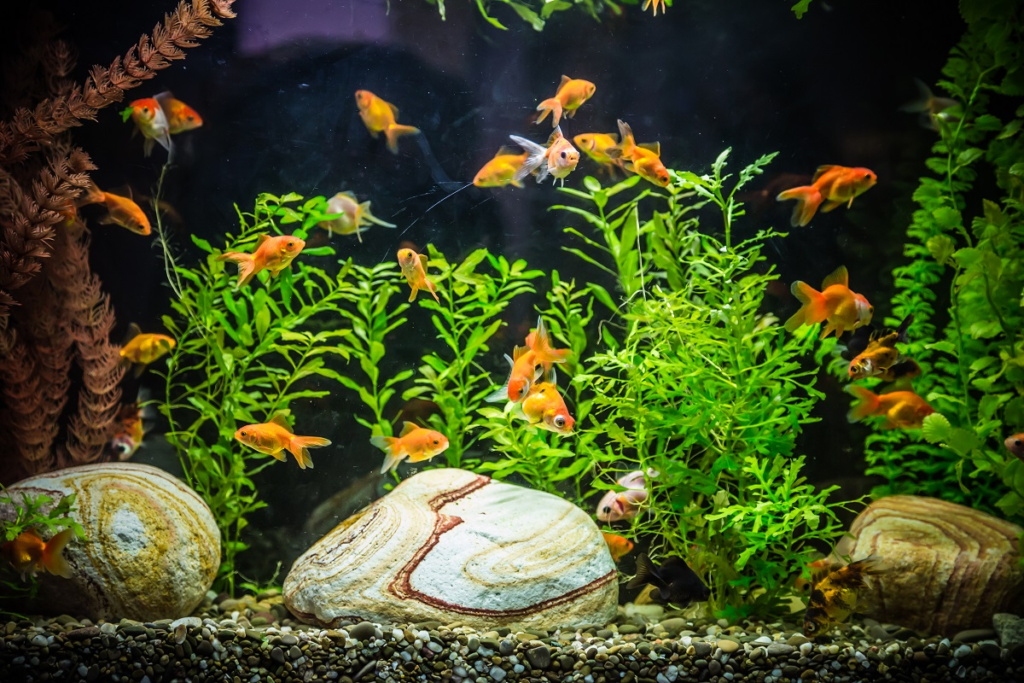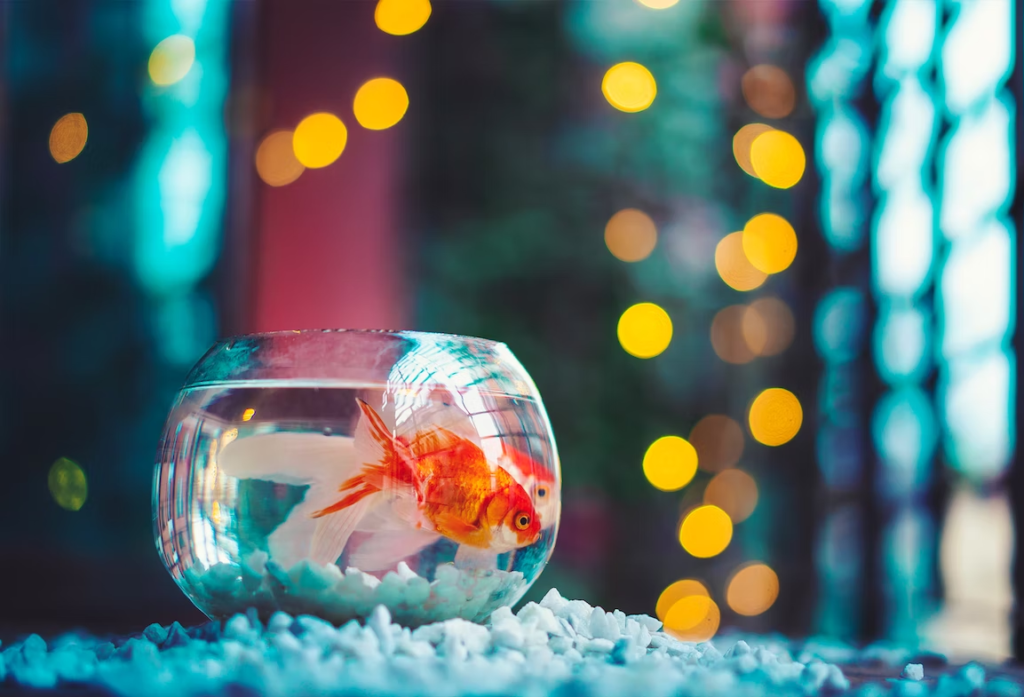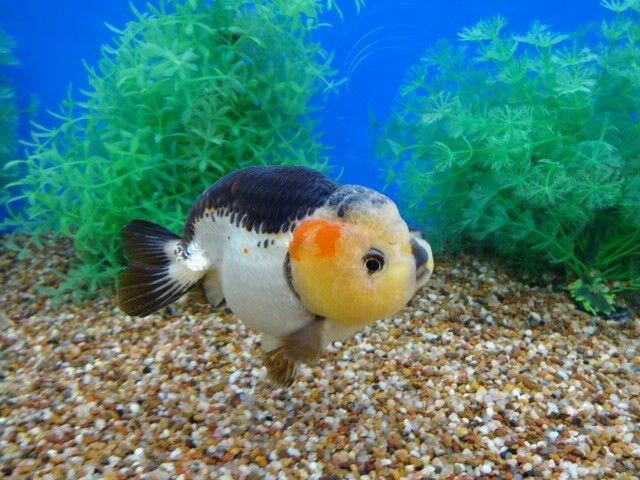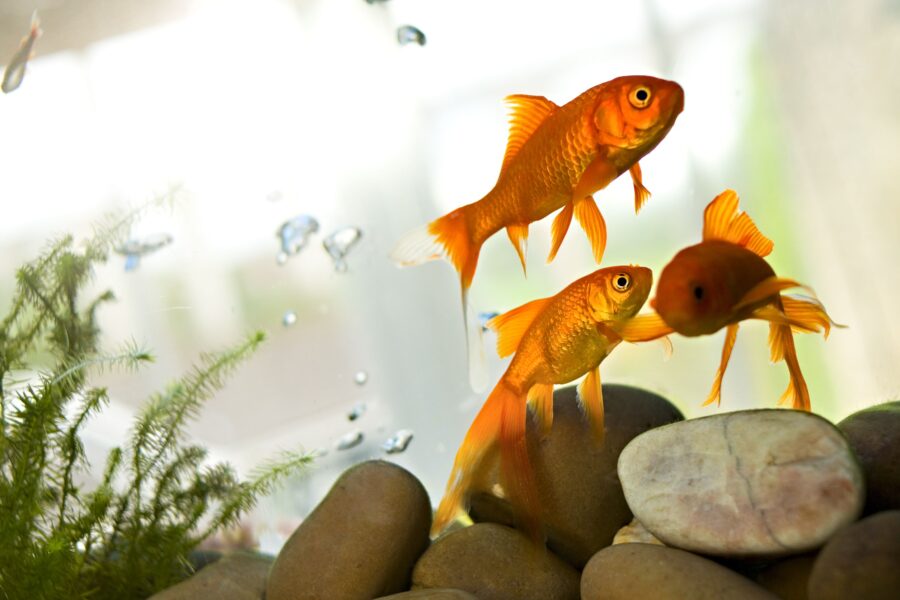
So you’ve taken the plunge (pun intended) and decided to add a baby goldfish to your family. Congrats! But now comes the often-confusing quest of finding the perfect underwater abode for your flippered friend. Whether you’re a newbie to aquatic pets or a veteran goldfish guardian, being knowledgeable about the habitat of your new baby goldfish can be the difference between becoming Captain Nemo or Captain Disaster. No worries, though. Allow me, your submarine guide, to navigate through this ocean of information and take you on a snorkeling trip down baby goldfish lane.
Why Choosing the Right Tanks for Your Baby Goldfish Matters

You might be thinking, “It’s just a goldfish. Why does the tank matter?” It’s a common question but hold that thought faster than a goldfish can do a fishy flip. Contrary to popular lore, a goldfish isn’t the aquatic equivalent of a cactus. It does more than just float around and nibble on fish flakes. A goldfish is a living, breathing, swimming work of art that, if housed properly, will flourish and entertain your family for years.
The type of tank that your baby goldfish calls home influences its health and happiness. Just like you won’t be comfortable living in a phone booth (hint: Superman was faking it), your baby goldfish won’t thrive in a cramped, unfiltered bowl. The right tank provides room for growth, space for play, and improved filtration that mimics their natural habitat. Ain’t that right, Nemo?
After we dive into this ocean of knowledge, you’ll emerge knowing how to make your baby goldfish’s home—a castle it truly deserves.
Top Myths about Housing Baby Goldfish
Now let’s debunk some common misconceptions that are as misplaced as a shark in a birdcage. Myth one: baby goldfish are perfectly suited to live in tiny bowls. False! That’s like saying you’d flourish living in a broom closet. Your perfect pet needs space to gallop, or in this case, swim.
Myth two: goldfish have a three-second memory. Not true! It’s been scientifically proven that goldfish remember their training for up to five months. So, if your goldfish seems to be ignoring you, it’s not because they forgot, they just have better things to do—like literally anything else.
One more for good measure: goldfish turn white in the dark. A surprising myth that holds no water, pardon my pun. They can change color due to various factors, but darkness is not one of them. They are just goldfish, not glow-in-the-dark disco decorations.
With the myths successfully torpedoed, let’s move on to appreciating the unique needs of your tiny finned friend. Be ready, because it’s time to deep-sea dive into the wonderful world of goldfish care!
Understanding the Unique Needs of Baby Goldfish

Baby goldfish, known in the fish world as ‘fry,’ are not just miniature versions of their adult selves. Like human infants, they require special care and conditions to ensure they grow up into happy, healthy adults. Hey, don’t we all wish we had that!
The Importance of Space to Goldfish Growth
Contrary to popular belief, goldfish will not just restrict their size to match their tank. The ‘a goldfish only grows to its environment’ concept is one, big, balloon-sized myth. A bit like Santa not delivering presents if you’ve been naughty. (Spoiler alert, even naughty kids get gifts!)
Goldfish are in fact rapid growers and require ample space to stretch their fins, play the harmonica, and maybe do a backflip or two. Without sufficient room, their development can be stunted, leading to health issues down the line. And nobody wants their goldfish to be a sulky, sofa-surfer.
A larger tank not only allows your baby goldfish the room to grow but also dilutes waste materials making the tank easier to clean. Kind of like hiding the toy clutter your kids leave around by throwing them into another room before guests arrive.
So remember, size does matter when it comes to your goldfish’s new crib.
Adapting to Changing Physical Features: From Baby to Adult Goldfish

Okay, now here comes the tricky part. Your adorable baby goldfish won’t stay baby forever. They transform like superheroes, and with time, their physical features will change too. But no need for a panic run to the pet store, these aren’t mutant goldfish we’re talking about!
Baby goldfish lack the striking coloration of their parents and often sport a uniform dull, grey, or olive color. But like an ugly duckling transforming into a beautiful swan, these little ones start to dress up in more vibrant colors as they mature.
Their needs also change. Changes in diet, based on size and nutritional needs, are crucial as your little Nemo or Dory graduates from fry-hood to being a ‘teen fish’.
Understanding and adapting to these rapid changes can ensure your little aquatic buddy grows up to be a healthy ‘goldie’ with a bright future.
What’s next after considering these needs, you ask? It’s all about the tank, mate! So, tighten your scuba gear, we’re about to dive into the key factors to consider when choosing a tank for your baby goldfish.
Key Factors in Choosing the Perfect Tanks for Baby Goldfish

It’s a common myth that goldfish are happy-go-lucky creatures, content to spend their lives in a pint-sized environment. But they’re a bunch of finned prima donnas when it comes to their lodgings. Get your feathered and furred pets what they want. But fish? Their demands are surprisingly complex.
Size and Volume – How Big is Too Big?
First thing’s first, when it comes to size, don’t think of it as a fish tank but as a GOLD-fish dream mansion. You’ve probably heard that goldfish are champions of adaptation, and they’ll adjust themselves based on their tank’s size. That’s not totally accurate. What’s actually happening is stunting, a malicious process affecting your tiny fish’s well-being. Have we caught your attention yet? Admit it, you’re a little bit hooked!
Imagine you are a goldfish. You’d want room to do laps, wouldn’t you? Perform a somersault or two? Do a vertical plunge? Indeed. Optimal size for a baby goldfish tank is 20 to 30 gallons – big enough not to stunt growth but small enough for effective filtration.
Shape and Its Influence on Your Baby Goldfish

Next, let’s dive into the shape factor. Picture this: you’re a goldfish. You have your own personalized castle – but it’s shaped like a boot. Fun as it might look, you’d be swimming in circles, feeling like you’re going nowhere, right? Now, translate that into fish terms. Circular and tube shapes should be avoided. Opt instead for longer, rectangular tanks which provide plenty of swimming passage and greatly reduce stress for your fish.
The Question of Material: Glass or Acrylic?
Up next: The red carpet clash of tank materials, glass versus acrylic. A Fashion-Fishyon Week of sorts for our little friends. Yes, your fish’s home fashion matters too!
So, should you go for catwalk-worthy glass that’s scratch-resistant and maintains clarity over time or trendy acrylic, which is much lighter and less prone to shattering? Decision making isn’t so easy in the deep end, is it? These materials each have their pros and cons, so it might be best to let your goldfish tiny couture (and budget) make the deciding call.
Why Good Filtration is Essential?
Finally, let’s filter through the importance of, well, good filtration. Your fish might not have the convenience of an ocean’s self-cleaning system, but it can have the next best thing. A good filter will remove waste, improve oxygen levels, and remove harmful chemicals. Think of it as the janitor; your tank needs that guy to maintain a healthy environment. Remember, a clean tank is a happy tank. And a happy tank is a happy fish. Is your mind swimming in information now?
That’s a crash course in choosing the perfect tank for your glittering hopper. You might be a tad disoriented from all this talk about shapes, sizes, and materials (Who knew fish tank shopping could be so involved?). But buckle up, because we are now heading to a meticulous comparison of the creme-de-la-crop of goldfish tanks. Are your fins fluttering in anticipation? They should be!
Top 5 Tanks for Baby Goldfish

Just like with any product, there are countless aquariums on the market that tout being the best home for your baby goldfish. But don’t let the flashy advertising fool you. Your little aquatic friend has specific needs that must be met to ensure healthy growth. Let’s dive right into some of the best tank options, so you can make an informed decision for your junior goldie!
Review and Comparison of Popular Tank Choices
- Marina LED Aquarium Kit: This is a great choice for your baby goldfish. It comes with a variety of sizes, but for baby goldfish, the 10-gallon size is the best. It includes an LED lighting module—and did someone say easy feed opening? Yes, please!
- Fluval Spec V Aquarium Kit: Talk about sleek and modern! It has a 5-gallon capacity, so it’s better for the smaller babies or for a temporary home. It includes a powerful filtration system and LED lighting.
- Tetra 20 Gallon Complete Aquarium Kit: If you’re looking for room to grow, this is a fantastic option. Its 20-gallon size gives your baby fish ample space to swim and grow, and it arrives complete with heating and lighting systems.
- Aqueon LED MiniBow Aquarium Starter Kits with LED Lighting: These cool little 2.5-gallon aquariums are perfect for a single baby goldfish. It’s compact, stylish, and comes with a neat elevated base.
- Seaclear Acrylic Aquarium Combo Set: If you’re ready to invest, this tank offers a more permanent solution. At 50 gallons, it’s big enough for your baby goldfish to grow into, but it’s best for those with a little more goldfish-rearing experience.
Whew! That’s quite a lot to take in, isn’t it? But fret not, we’ll break down what makes these tanks good choices for your baby goldfish next.
What Makes Them Suitable for Baby Goldfish?

What these tanks have in common is their quality filtration, which is critical for goldfish, who can be quite messy eaters (remind you of anyone?). The adequate tank volume from the Marina, Tetra, and Seaclear tanks give room for the baby goldfish to swim, play, and grow.
Furthermore, they all have good lighting systems that mimic natural sunlight, promoting healthy growth (much like that much-needed sunlight us humans need!). Tanks like the Aqueon MiniBow and the Fluval Spec V, while smaller, are perfect for first-time goldfish parents or for housing smaller babies.
Suiting up in your metaphorical armor and choosing the right place for your baby goldfish to call home can be an epic journey. And our journey is far from finished! Up next, let’s talk about transitioning your growing goldfish to more adult-like residences. Are you ready? Of course, you are! Make sure that armor is securely fastened though – things are about to get real!
Transitioning Your Baby Goldfish to Adult Tanks

Goldfish, bless their cute and colorful hues, don’t actually stay babies forever. Surprise! They’re kind of like your teenager who suddenly requires an entire pizza to themselves. In the goldfish world, a growing goldfish that’s morphing into a mature, majestic fish necessitates a home upgrade. Aw, they grow up so fast, don’t they?
Upgrading Your Tank As Your Goldfish Grows
No, your goldfish won’t need a king-sized bed or a gaming chair, but they do need more swimming space. Their evolutionary grand plan includes a spurt of growth that turns them into veritable waterborne giants.
The hole-in-one trick here is realizing that a larger tank isn’t just about accommodating growth – it’s also about preserving health. It’s a whimsical Goldilocks situation – not too small, not too big, but just right to keep Goldie happy and hale. Here’s a hot tip – starting with a tank slightly larger than necessary can save you both the shock of sudden shifts and the financial pain of frequently upgrading.
Remember the joy you felt moving from your teensy apartment to a more spacious one? Well, the same thrill awaits Goldie when you upgrade their tank.
How to Smoothly Transition Your Goldfish to a New Home
Pulling off a seamless transition is trickier than a successful tickle fight with a crocodile – but don’t worry, we’ve got the goods to help! The key is gradual acclimation. Just like you’d prefer a warm-up before a marathon, introducing Goldie to their new home gradually can ease the transition.
Aquatic experts recommend the drip method. Save the eyedropper for your common cold. Instead, add small amounts of water from the new tank to the old one over several hours. Vibing with the new water chemistry will be less stressful this way. The environment changes at a slow pace (like molasses, or an arthritic turtle).
Then, using a soft net, gently transport Goldie to their swanky new crib. Trust us, they’ll have the fishiest grin plastered over their cute little face.
So, folks, with a little vigilance and gentleness, transitioning your baby goldfish to bigger and better tanks can be pretty smooth sailing (pun intended!). Wiping your brow yet? Fear not, as we sail toward the conclusion, we’ll recap why your journey through the wild seas of goldfish parenting matters so much, and throw in some quirky goldfish trivia to keep you entertained. Now, ready to jump into the sea of funfish facts?
Wrap Up

Why Acting on This Information Can Increase The Lifespan of Your Goldfish?
Here’s the bottom line, fishy folks – while goldfish might not write you heartfelt thank-you notes, your loving attention to their environmental needs, particularly tank selection, can work wonders on your underwater pals’ wellbeing. Experts often liken tank sizes and features to the quality of human living environments. Imagine being cooped up in a closet… yet your closet also happens to be your kitchen and bathroom. Doesn’t sound very appealing, does it? Similarly, giving your baby goldfish enough space, proper filtration, and the right material can drastically enhance their growth, health and overall lifespan.
Researching tank types and considering future plans may feel like overkill or scheduling your goldfish’s college tours (they do grow up so fast!). Still, trust me when I say it’s all worth it. You’ll be ensuring you’re the best goldfish parent out there, one knowledgeable enough to skip common pitfalls that could potentially hamper your baby’s development. Plus, you’re also cementing your potential nomination for the ‘Goldfish Parent of the Year’ award! But hey, I don’t hold the voting rights, your goldfish do!
And not to dampen the spirits but misconceptions persist about goldfish care. Do they have a 3-second memory? Can they survive in a bowl permanently? Answers to these questions and more, coming up in my future articles.
Fun Facts about Goldfish and Teasing Upcoming Articles
Alright! Before we wrap up, let’s add a splash of trivia to make you the star at your next dinner party (or underwater tea party with your goldfish, no judgment here!). Did you know goldfish can recognize their owners? Yes, they might not come wagging their tails like your dog, but they can distinguish your face from others’. Another fun nugget, goldfish don’t have stomachs! They have a straight digestive system, so feeding them smaller meals spread across the day will help maintain optimal health.
Well, that’s it, folks! All the golden gulps of wisdom for today. But don’t say goodbye just yet – I’ve got more fishy tales coming your way. Our next stop: “Everything You Need To Know About Goldfish Food.” We’ll bite into the many dietary nuances of goldfish, debunk the flake food myth, and reveal answers to the burning question: Can your goldfish turn into a cookie monster if you feed them cookies? Find out in the upcoming posts! Tuna in (pun intended) for more fun and frolic in the fabulous world of fish!
Frequently Asked Questions (FAQ)
Q1: Why does the right tank matter for my baby goldfish?
A: The tank size highly influences your goldfish’s growth and longevity. Keeping them in the right tank helps regulate their stress levels which in turn promotes a healthier life.
Q2: How big should my goldfish tank be?
A: Goldfish need ample space to grow; a common rule of thumb is to provide 20 gallons for the first fish and 10 for each additional one. However, size requirements can vary based on species and growth rates.
Q3: Are there specific tank shapes that are suitable for baby goldfish?
A: Yes. Rectangle-shaped tanks are generally recommended because they provide enough surface area for oxygen exchange, crucial for goldfish.
Q4: Is there a difference between glass and acrylic tanks?
A: Yes, there is. Glass tanks are scratch-resistant and less likely to discolor over time. In contrast, acrylic tanks are lighter and more impact-resistant but can scratch easily.
Q5: How vital is good filtration for my baby goldfish tank?
A: Extremely vital! A good filtration system results in a cleaner tank by removing waste, leftover food, and potentially harmful chemicals, essential in maintaining the tank’s overall health.
Q6: When should I transition my goldfish from a baby tank to an adult one?
A: When your goldfish begins outgrowing its current tank and becomes physically mature, it’s time for an upgrade. We cover this transitioning process in section 5.
Q7: Can acting on this information really increase my goldfish’s lifespan?
A: Absolutely! Providing your goldfish with a suitable environment and proper care can significantly boost their lifespan, sometimes living up to 10 to 15 years!
Q8: Are there really fun facts about goldfish?
A: You bet! For example, did you know goldfish don’t have stomachs? Or that they can recognize faces? Stay tuned for more goldfish-related content!



